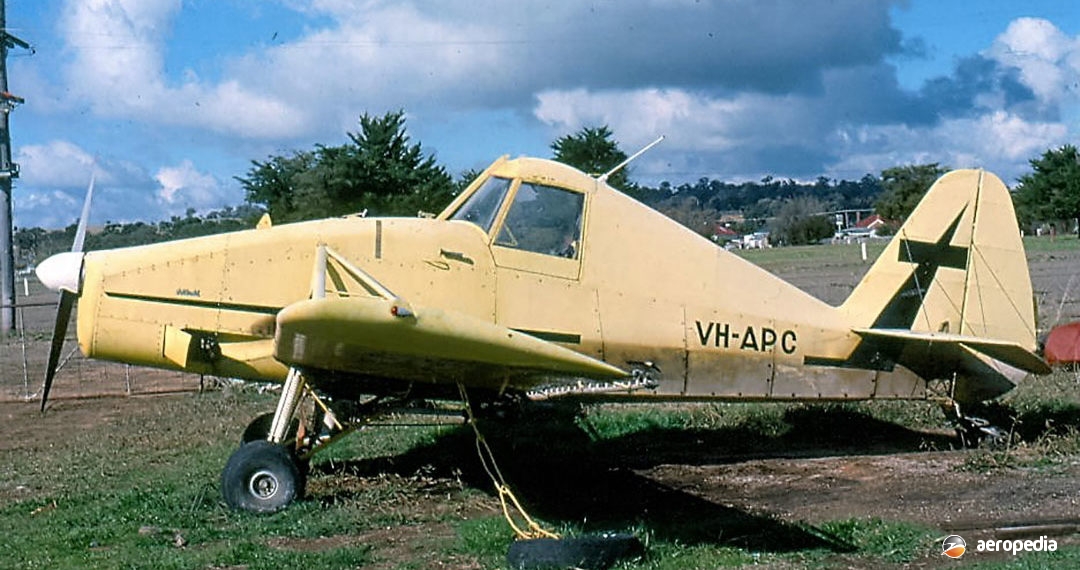Photograph:
Call Air A-9 VH-APC3 (c/n 1074) at Cootamundra, NSW in June 1979 (David C Eyre)
Country of origin:
United States of America
Description:
Single-seat agricultural monoplane
Power Plant:
One 175 kw (235 hp) Lycoming O-540-B2-B5 six-cylinder horizontally-opposed air-cooled engine
Specifications:
- Wingspan: 10.67 m (35 ft)
- Length: 7.32 m (24 ft)
- Height: 2.44 m (8 ft)
- Wing area: 16.91 m² (182 sq ft)
- Max speed: 191 km/h (119 mph)
- Cruising speed at 75% power at 862 kg (1,900 lb) gross weight: 185 km/h (115 mph)
- Cruising speed at 75% power at 1,361 kg (3,000 lb) gross weight: 169 km/h (105 mph)
- Rate of climb at sea level: 198 m/min (650 ft/min)
- Service ceiling: 4,267 m (14,000 ft)
- Empty weight: 680 kg (1,500 lb)
- Loaded weight: 1,360 kg (3,000 lb)
History:
The Call Air A-9, which first appeared in Australia in the mid 1960s, was developed from a line of agricultural aircraft originally built by Call Air Inc of Afton, Wyoming. In 1967 the Company was taken over by the Inter Mountain Manufacturing Company which renovated the manufacturing facility and designed and built the A-9. A total of 770 aircraft was completed and then the production line closed down, the rights to the type being sold to a company in Mexico in 1971.
The prototype flew for the first time in 1963 and production commenced in March of that year. Some 25 examples were imported to Australia by the distributors, Aerial Agriculture Pty Ltd of Bankstown, NSW.
Resembling the Piper Pawnee in many ways, and utilising the same engine, the A-9 was of rugged construction with an all-metal fuselage fabricated from chrome-molybdenum tubular steel with a turnover structure designed to withstand loads in excess of 4,082 kg (9,000 lb). A 0.85 m³ (22.5 cub ft) or 772.8 litre (170 Imp gal) fibreglass hopper was located forward of the cockpit. Unlike the Pawnee, the A-9 featured spruce wingspars, which the manufacturer claimed would shear in a crash rather than transmit their load and deforming the rest of the structure. The ribs were fabricated from sheet aluminium, and the leading-edge of the wing was covered with aluminium alloy sheet. The wings and rear fuselage, except where removable metal panels were fitted, were covered with dacron-polyester fabric. Wire cutters were attached to the leading-edges of the main undercarriage legs, and in front of the pilot’s windscreen.
One A-9B was imported by WA Aerial Services of Cunerdin, WA, but certification problems led the company to convert it to A-9A configuration. It later became VH-MPU. Australian registered A-9As have included: VH-FBS (c/n 1061) first registered in May 1964 and operated by Superspread Aviation Ltd and later Robbys Aerial Service Ltd; VH-MPA (c/n 1063) with Robbys, K W Forrest and the Adelaide Soaring Club, later becoming VH-AZE; VH-MPB (c/n 1067) with Superspread Aviation Ltd and later I L Dunn, retired in 1987; and VH-MSU (c/n 1068) with Marshall’s Spreading & Spraying Service which crashed near Bundaberg, QLD on 25 August 1969.
VH-MPD (c/n 1070) operated with Robbys and Western Aerial Services; VH-MPC (c/n 1071) with Superspread Aviation which crashed at Narromine, NSW on 1 September 1977; VH-APC (c/n 1074) with Queensland Air Planters Ltd; VH-MPE (c/n 1085) with Superspread Aviation; VH-APW (c/n 1097) with Queensland Air Planters which crashed at Bundaberg, on 22 February 1965; and VH-MPF (c/n 1107) with Aerial Agriculture Pty Ltd which crashed at Batchelor, NT on 5 July 1981.
VH-TOX (c/n 1113) of T J Fleming crashed at Henty, NSW on 5 July 1965; VH-MPN (c/n 1127) of Superspread Aviation; VH-MPG (c/n 1128) of Aerial Agriculture and Western Aerial Services; VH-MPH (c/n 1129) of Aerial Agriculture which crashed at Kondut, WA on 20 August 1968; VH-CYC (c/n 1169) of William Flying Service, Aerial Agriculture and the Geelong Gliding Club, retired after an accident in 1968; VH-MPI (c/n 1171) of Robbys Aerial Service and Queensland Air Planters which was damaged in an accident at Whim Creek, WA on 25 November 1979; VH-MPJ (c/n 1172) registered in 1965 to Robbys Aerial Service Ltd, later Queensland Air Planters Pty Ltd, which crashed near Mento, QLD on 13 May 1974; VH-MPK (c/n 1190) of Aerial Agriculture; VH-MPL (c/n 1192 – ex N255, N26B) of Aerial Agriculture and the RAAF Richmond Gliding Club; and VH-MPP (c/n 1203) of Pay & Williamson Ltd, later Murrayair (Albury) Pty Ltd, retired in February 1980.
VH-MPO (c/n 1207) with Kun-Air Krop Control crashed at Cathkin, VIC on 20 May 1974, finally crashing again near Deniliquin, NSW on 24 November 1979; VH-KKZ (c/n 1218) with Kun-Air Krop Control from 1965, being lost in an accident at Kununurra, WA on 2 January 1966; VH-MPQ (c/n 1219) with Ord River Crop Control Pty Ltd which crashed at Farm Hill, WA on 16 January 1970; VH-MPR (c/n 1233) with Kun-Air Krop Control and Aerial Agriculture, being retired in 1974; and VH-MPS (c/n 1242) with Ord River Crop Control, Kun-Air Krop Control and Top End Gliding Club which ditched near Cottesloe Beach, WA on 11 March 1978.
A number of A-9s have remained airworthy in Australia, mostly these days being operated in the glider-towing role. Most are painted overall yellow, the colour scheme they originally received when manufactured.

